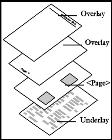Pages and Layers
The relationship between pages and layers in
PTC ALD is simple. A main page contains the frame(s) that by themselves can make up a simple page layout (see
Frames for further information about frames). Additional layers can be applied to this base page to build it up and create a more complex, optionally contextual, layout if required.
| A page is not an area that contains text. It is an area upon which frames are placed to contain that text (and other information types). The page only contains controls to manage the placement of registration and trim marks. |
Layers
The list below contains some basic facts about layers:
• A layer is a page layout comprising a set of frames. It is stored as a tag.
• Up to ten layers can be applied to a single page, although there is no limit to the number of layers that you can make available for allocation to the page.
• There are two types of layer: underlay and overlay. An underlay is placed under the base page, and an overlay above it. This allows for the logical build of a page and the calculation of contextual information (see below).
• Information can be passed from the bottom layer of a page to the top one, thus ensuring that the whole of the page is used as a reference point when calculating contextual information. As an example, if you wish to have running headers in your document it makes sense to place the document's content in an underlay and the running headers in a frame in an overlay. The header information from the content stream in the underlay can then be processed and passed to the running header in the overlay for output.
• The "bottom up" method of processing information in layers will also ensure that frames in the topmost layers of a document will affect the content of those below them. For example, adding frames to the page or overlay layer will force the content in the underlay to flow around them.
• Layers can also be applied on selected pages only, for example if you wish to create different footnote information for left-and right-hand pages. This form of creation is controlled with page sequence control streams.
• Layers can be sized individually without reference to the base page size. On output the page will be adjusted to the minimum size to accommodate all the layers that have been allocated to that page, even if they are wider or longer than the base page.
• Layers can be created and applied via the tplay macro or the > menu option. Here you will be presented with a dialog box in which you can enter name, size and placement information for the layer.
Once created, you can pick the layer from the blue bar on the left of the PTC ALD window, when in Page/Frame Mode.
Page Sequences
Page sequencing forms part of the formatting stage of document production with PTC ALD and ensures that the correct quantity and type of pages and frames are output to contain the content streams that have been allocated to a document. The page sequence of a document can be created and controlled in the following ways:
• Master and copied pages: the autocopy process, defined via the tpacopy macro or the > menu option, creates a master page for a particular text stream so that if, after formatting that master page, PTC ALD finds that the whole stream will not fit onto one page, it will use the master page as a template and insert additional copied pages until the text stream is ended. The inclusion of a marker indicates to the formatter the end of the text stream and hence that no more pages are required (this can be seen as a red marker in the WYSIWYG view of the document when page guides are activated). A template can comprise numerous master pages and in this way it is possible to allocate multiple content streams to a single document.
• Page sequence control stream: a .Ps tag that provides a sequence of rules to determine which page layout to use at a particular stage in the formatting of a content stream, for example inserting a landscape page into a document with a portrait layout or effecting a different layout for the first and last pages of a chapter. Page control sequences can, in turn, be controlled by a document sequence control stream (.Ds tag), which defines the order and frequency by which the page control sequences should be applied to a document.
• Inline PIs: an inline instruction <?layer> can be used to apply a layer to, or remove it from, a single page or a range of pages on an ad hoc basis within a document.
• Manual addition or removal: usually a desktop tweak of an automated page creation process, a desktop user can add or remove pages via
PTC ALD's Document Mode interface (see
Document Mode for further information).


